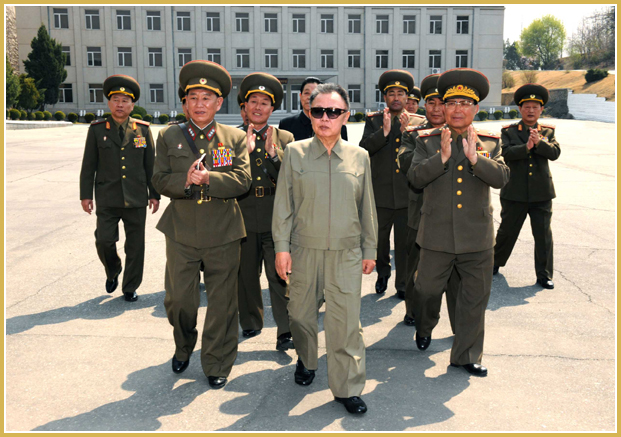Nerve Center of DPRK's anti-ROK Operations
Kim So-hyun has a comprehensive report in the Korea Herald about the NDC Reconnaissance Bureau, which would manage an attack such as the Cheonan.
Government sources also reportedly said that the “130-ton Yeono class submarines,” one of which torpedoed the South Korean warship, are mostly deployed by the Reconnaissance General Bureau instead of the North Korean navy.
The Reconnaissance General Bureau of the Korean People’s Army is known as the heart of North Korea’s international espionage activities and acts of terrorism, according to officials here.
The North Korean state media said on April 25, the founding day of the country’s army, that the country’s leader Kim Jong Il visited the commanding headquarters of “Unit 586,” another name used on official occasions for the Reconnaissance General Bureau.
It was the first reported visit by Kim, chairman of the National Defense Commission, to the spying agency, drawing attention to why he chose to visit it on the founding day of the KPA, about a month after the Ch’o’nan’s sinking.
The Reconnaissance General Bureau is one of the KPA’s three most powerful organs. The general bureau is an integration of the reconnaissance department of the North Korean defense ministry, the “operations department” which developed infiltration routes for secret agents and “Room 35” in charge of international intelligence under the Workers’ Party.
The general bureau now consists of six bureaus for operations (Bureau 1), reconnaissance (Bureau 2), overseas intelligence (Bureau 3), inter-Korean talks (Bureau 5), technology or cyber terrorism (Bureau 6) and for support of other divisions (Bureau 7), according to sources. There is no Bureau 4 due to a traditional Korean taboo on the number four, which is pronounced the same as “death” in Korean.
Bureau 1, in charge of training and infiltration of secret agents, reportedly has liaison offices in the coastal towns of Haeju, Nampo, Wonsan, Chongjin for naval infiltration. O Kuk-ryol, vice chairman of the NDC, has led the operations bureau for the past 20 years. Bureau 2, known for having led the North’s attempted raid of Cheong Wa Dae in 1968 and the submarine infiltration in Gangneung in 1996, is in charge of terrorist activities.
Most recently, the reconnaissance bureau allegedly ordered the assassination of former Workers’ Party secretary Hwang Chang-yo’p who defected to South Korea in 1997. Bureau 3 (overseas intelligence) is a reorganized version of what was formerly called “Room 35” under the Workers’ Party. Room 35 is known for having kidnapped a South Korean actress-director couple in 1978 and bombing a Korean Air passenger flight in 1987.
Chosun Ilbo citing Open Radio for North Korea, reports on rumors of a support role by the KPA Navy Command:
“North Korea’s Navy Command planned the Cheonan attack around Jan. 8,” the birthday of leader Kim Jong-il’s son and heir apparent Jong-un, “and the Reconnaissance Bureau led the mission by deploying a submarine and a mini-sub,” Ha told a press conference Wednesday.
Citing sources in North Korea, Ha said, “The submarine protected the mini-sub, which was carrying two mid-sized torpedoes and two mines for self destruction should the mission fail.” All six operatives on board the mini-sub were given hero status back in North Korea, and the crew of the accompanying submarine were also awarded top medals, he added.
Ha cited three reasons why Kim Jong-il approved the attack: to avenge the North’s defeat in a naval clash near Daecheong Island in the West Sea in November last year, to test out new stealth submarines and strategies, and to ratchet up tensions in order to facilitate the succession. “Kim Jong-il visited the naval command with Jong-un to boost morale at the end of December after the defeat in the West Sea,” Ha said. “He did not fire any high-ranking officials responsible for the naval defeat, but ordered them to seek revenge.”
The North Korean Navy’s headquarters and an army division in the West Sea supported the mission, he said. The plan was reviewed by the minister of the People’s Armed Forces, Kim Yong-chun, and Vice Chairman of the National Defense Commission O Kuk-ryol. Ha said Kim Jong-un probably compiled the reports filed by the defense commission and briefed Kim Jong-il.
Ha pointed to Kim Jong-il, Kim Yong-chun, O Kuk-ryol, as well as North Korean Navy Commander Jong Myong-do and Kim Yong-chol, head of reconnaissance operations, as the five main culprits behind the attack on the Cheonan. “A day before the attack on the Cheonan, North Korea ordered the West Sea fleet and army division to prepare for combat.” He claimed that soldiers were told the alert was in preparation for joint South Korea-U.S. military exercises but ordered to fight back if the South Korean Navy chased the sub after the attack.
KJI has recently demonstrated a special affection for the KPA Navy Command. The aforementioned Jong Myong Do was promoted to General on 14 April 2010, part of the Day of the Sun/KIS Birthday military promotions list. KJI also made a point of conveying the high regard in which he holds KPA Navy Combined Unit #587, during a November 2009 inspection. In a KCTV special broadcast on 25 April (KPA Day), an officer of the unit recalled KJI’s visit:
. . . notes how he personally came on board a docked vessel, looked after the soldiers’ everyday living with a fatherly love, and “gave a precious teaching on all the more modernizing the vessel’s weapons, combat, and technical equipment in accordance with the demand of modern warfare.” He continues to note how Kim Jong Il came on board another vessel and watched combat training of sailors. . .and mentioned that Kim Jong Il said, “Comrades, do you know why I come to this unit often? It is because as supreme commander, I have such strong confidence in this unit. I urge you to reinforce your training in the future and firmly prepare all the sailors into vigorous one-a-match-for-100 all-round sailors and as the do-or-die unit of sea heroes.”
